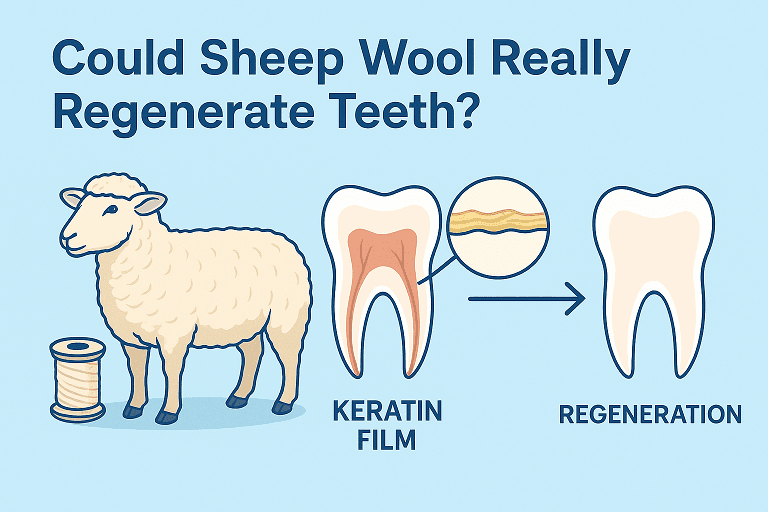Social media has recently buzzed with claims that keratin from sheep’s wool can “regenerate your teeth and put an end to cavities forever”unionrayo.com. Such statements echo sensational summaries of a recent lab study, but they dramatically oversimplify the science. In reality, researchers at King’s College London have shown that keratin, a protein in hair, skin and wool, can form a mineral-coated film on enamel in laboratory testslivescience.comconexiant.com. However, this work is very preliminary. Dental experts emphasize that enamel lost to decay does not spontaneously regrowrdhmag.com, and the wool-based approach is not a magic bullet. In this article we review the published research on wool-derived substances for enamel repair, explain the proposed mechanisms, and critically assess whether current evidence could support any clinical benefit.
Viral Claims vs. Research Reality
Online news sites and social posts have amplified this story with headlines like “sheep wool regenerates your teeth”unionrayo.com. Such pieces often suggest that simply applying wool-derived proteins could cure cavities, but no peer-reviewed data justify those broad claims. In fact, the original study focused on very specific conditions: treating early enamel lesions (white spots) in a laboratory settingpubmed.ncbi.nlm.nih.govconexiant.com. The research showed that a solution of keratin extracted from wool can adhere to a tooth surface and, in contact with a mineral-rich solution, build up an enamel-like layerlivescience.comconexiant.com. However, even the study authors caution that these findings are in vitro and that clinical trials are neededconexiant.comrdhmag.com. No published research to date has demonstrated that keratin (or any wool component) can rebuild a tooth or fill large cavities in a patient’s mouth.
In short, the viral narrative that wool “regenerates your teeth” is overstated. The study itself reported promising laboratory results on enamel remineralization – essentially helping to rebuild tiny mineral losses on the tooth surface – but it did not claim a “cure-all” for tooth decayunionrayo.compubmed.ncbi.nlm.nih.gov. The language of news summaries often blurs this distinction. For example, a dental trade article noted that “keratin… has been shown to not only repair tooth enamel but prevent early stages of decay”rdhmag.com. That sounds impressive, but it refers to experiments on artificially-demineralized enamel, not on advanced cavities. Until clinical studies are performed, these treatments remain speculative.
Keratin Films: Laboratory Evidence and Mechanism
Figure 1. Dr. Sherif Elsharkawy and his team at King’s College London extracted keratin from raw sheep wool to develop an enamel-repair coating (image: King’s College London). In the experimental protocol, scientists mixed wool-derived keratin with water and applied this solution to tooth samples. When exposed to artificial saliva (containing calcium and phosphate), the keratin assembled into a fibrous network that attracted minerals and grew a hard, crystal-like layer over damaged enamellivescience.comconexiant.com. Microscopy confirmed that this new layer was similar to natural enamel in structure (forming roughly 40–50 μm thick, tightly aligned hydroxyapatite crystals)conexiant.comlivescience.com. Mechanical testing showed that keratin-treated enamel recovered much of its hardness and elasticity: in one comparison, treated lesions were 5–6 times harder than conventional resin-infiltrated lesionsconexiant.comlivescience.com.
These findings indicate that keratin can serve as a biomimetic scaffold for enamel mineralizationpubmed.ncbi.nlm.nih.govconexiant.com. In healthy enamel, proteins (primarily amelogenin and other minor components) guide formation of hydroxyapatite crystals; keratin appears to mimic some of that function. (Interestingly, genetic studies have shown that keratins are naturally present in enamel. A 2014 study found that certain “hair” keratins are incorporated into the enamel rod sheath, and mutations in the keratin 75 gene led to softer enamel and much higher decay ratespmc.ncbi.nlm.nih.gov.) By providing a protein matrix, wool keratin films help calcium and phosphate re-precipitate in an organized way on the tooth surfacepubmed.ncbi.nlm.nih.govconexiant.com.
In laboratory models of white-spot lesions (early enamel decay), this approach was effective at building new mineral layers. However, it is important to stress that all evidence comes from in vitro tests: tooth samples in controlled conditions. The real oral environment has continuous saliva flow, oral bacteria and acids, and mechanical wear, none of which were fully replicated in the labconexiant.com. Long-term durability, potential side effects, taste/experience of a wool-based coating, and proper dosing were also not addressed. As one summary notes, “the study was performed entirely in vitro… Long-term durability of the regenerated enamel was not assessed, and cytocompatibility and safety studies are still needed before clinical application”conexiant.com.
Wool Components and Proposed Mechanisms
Scientists have mainly focused on keratin as the active component for enamel repair. Wool also contains lanolin (a waxy fat) and trace amounts of other proteins, but these do not play a role in mineralization. For clarity:
-
Keratin (wool/hair protein): A sturdy fibrous protein that the researchers processed into thin filmspubmed.ncbi.nlm.nih.govconexiant.com. In experimental models, keratin films provided an organic scaffold on the tooth surface. When exposed to remineralizing solutions, the keratin layer directed growth of enamel-like hydroxyapatite crystals, gradually forming a hard protective coatingconexiant.comlivescience.com. The in vitro tests showed that these keratin-induced mineral layers could restore hardness to demineralized enamelconexiant.com. This mechanism is plausible because keratins are biologically compatible with tooth material and actually occur in enamel structurepmc.ncbi.nlm.nih.gov.
-
Lanolin (wool wax): A yellow fatty substance obtained from sheep’s woolgo.drugbank.com. Lanolin is commonly used as an emollient in skincare products due to its moisturizing and mild antimicrobial propertiesgo.drugbank.com. There is no evidence that lanolin contributes to enamel regeneration. Lanolin is a lipid (not a protein) and does not provide a mineral-binding scaffold, so it would not guide hydroxyapatite formation on teeth. Its known uses (e.g. lip balm, ointments) are unrelated to hard-tissue repair.
-
Other wool-derived proteins: Besides keratin, wool has negligible amounts of other proteins or peptides. None have been studied in the context of dental health. No “bioactive enzyme” or growth factor in wool is known to influence teeth. In short, keratin is the only wool component identified as having any potential for enamel repair in scientific literature.
In sum, the only scientifically plausible factor from wool is keratin. Even so, the laboratory results pertain to helping early enamel lesions remineralize. They do not imply that a person can regenerate dentin or pulp, or regenerate an entire tooth. The enamel-like layer produced by keratin is a surface coating; it relies on underlying enamel to exist. If deep cavities have already eaten through enamel into dentin, a keratin paste would not regrow the lost structure – it might at best slow further decay of the remaining tooth surface.
Expert Commentary and Caveats
Dental experts caution that the keratin-based approach is intriguing but very early-stage. In major media coverage, non-author authors said things like “keratin is very promising” but emphasized the need for clinical trialswashingtonpost.comconexiant.com. For example, Dr. Marianne Bertolini (University of Pittsburgh) noted that the study did not test a consumer product, so issues like taste, safety and effective dosing remain unknownwashingtonpost.com. Dr. Sami Dogan (Univ. of Washington) called it a “promising technology” but said it is still years from practical usewashingtonpost.com. The editors of prominent dental journals also underline caution: King’s College researchers themselves say that patient studies are needed to confirm the effects. As one summary puts it, “these findings establish keratin as a [possible] biomaterial for enamel repair”, but they admit that in vivo validation is pendingconexiant.comwashingtonpost.com.
It is also worth noting what current standard treatments do. Today, fluoride toothpastes and varnishes are known to remineralize early enamel loss and slow decay, though they don’t form thick new enamel layers. Resin infiltration can seal white-spot lesions but generally doesn’t fully restore hardness. The keratin film in lab tests outperformed a resin infiltrant in hardness recoveryconexiant.com, but again, only in a petri dish, not a mouth. As one expert pointed out, conventional enamel does not regenerate on its ownrdhmag.com, so any laboratory-guided repair is notable — but it doesn’t mean fillings or crowns become obsolete overnight.
Finally, the viral hype ignores practical concerns. Wool-derived keratin treatments would need to be manufactured under strict conditions (avoiding contaminants and pathogens). A person brushing at home with raw wool would almost certainly not achieve anything. Moreover, the researchers themselves say that if all goes well, products like a keratin-infused toothpaste or dental gel might appear in “a few years”washingtonpost.com. But they stress further refinement and testing is required.
Implications for Dentistry
What does this mean for dental clinicians? First, continue relying on proven preventive care. Regular fluoride use, good oral hygiene and timely treatment of decay are still the best defenses against cavities. For now, keratin films from wool are not a clinically available treatment. Dentists should be aware of the research trend as a potential future tool, but also be ready to explain to patients why “toothpaste from wool” is science-based speculation, not a home remedy.
In the longer term, if keratin-based biomaterials prove safe and effective in humans, they could complement our current toolkit. For example, a keratin gel applied by a dentist might help strengthen early lesions without drilling. Or a keratin-containing paste could boost mineral delivery in patients with high caries risk. The wool study represents a novel “regenerative” approach, aligning with broader efforts in dentistry to harness organic matrices and peptides for tooth repairconexiant.compmc.ncbi.nlm.nih.gov. It also exemplifies a sustainable strategy, recycling a biological byproduct (wool or hair) into healthcare usepubmed.ncbi.nlm.nih.govrdhmag.com.
Conclusion
In conclusion, scientific research does not currently support the sensational claim that sheep’s wool can regenerate teeth in humans. However, it does suggest that keratin – a protein abundant in wool – can help guide enamel remineralization under laboratory conditionspubmed.ncbi.nlm.nih.govconexiant.com. This insight opens an interesting avenue for biomimetic dental materials, but it is not an overnight cure for cavities. Any future wool-based dental product will require careful clinical testing. Until then, dental professionals should view the sheep-wool narrative critically, inform patients of the true state of the science, and focus on evidence-based prevention and treatment strategies.
References: Peer-reviewed sources and expert analyses on keratin and enamel remineralizationpubmed.ncbi.nlm.nih.govpmc.ncbi.nlm.nih.govconexiant.comrdhmag.com; news reports and press releases summarizing the latest studieslivescience.comwashingtonpost.com; plus discussion of misinformation in the mediaunionrayo.comgo.drugbank.com.
.gif)



Share your thoughts, Get involved!
Comments